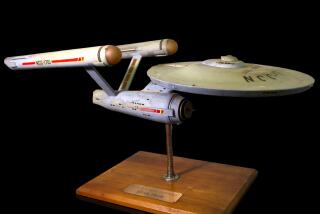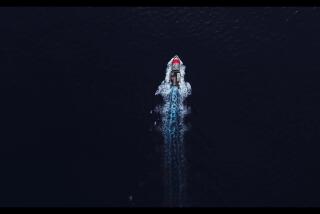L.A. Man Plans Salvage of Civil War Battleship : USS Kearsarge, Forgotten Almost a Century, Believed to Be Sunken Vessel in the Caribbean
Welcome, brave Kearsarge’s crew;
Welcome notes now ring for you;
Smiling faces all around
Bid the welcome notes resound.
--1864 song to the U.S. Sloop-of-War Kearsarge written by the Rev. Phineas Stowe, First Baptist Mariners’ Church, Boston.
It began as an underwater glimmer on a shallow bottom near a hungry Caribbean reef.
A Honduran lobster diver, Miguel Dixon, brushed sand with his hand and picked up a bronze spike. Then a metal pin and an anchor chain. Then he saw the full litter of barnacled wood.
One Thought
Dixon held one thought as he surfaced: Considering the reputation of these waters, the wood and metal must be clues to a gold galleon.
They weren’t. As it now is almost certain, their antiquity may be no earlier than 1861, their origins no more glamorous than the Navy Yard at Portsmouth, N. H.
Yet there is little doubt that they are trove and historically priceless . . . as fastenings and leavings from the USS Kearsarge, a legend of Civil War naval action.
“She was the victor in the war’s only ship-on-ship engagement outside United States waters,” Steven Morgan said.
He’s a buccaneer’s namesake from Los Angeles who has spent two decades diving for sunken history and lost gold. Now he is preparing to recover the Kearsarge and bring her remains home.
“Everybody’s heard about the USS Constitution, the Merrimac and the Monitor . . . but the Kearsarge was the most famous ship to see action during the Civil War, a prized piece of history.”
Lincoln’s Choice
The steam and sail-powered Kearsarge (from the hard oak lumbered at Kearsarge Mountain in New Hampshire) was President Abraham Lincoln’s personal choice to dog the Alabama, a Confederate titan that in three seasons (1861-64) was 66-0 against Union shipping.
The Kearsarge eventually shot it out with this Rambo four miles off the French port of Cherbourg. The Confederate privateer went down after an 80-minute duel (more than 500 shells were exchanged) and her end was duly and masterfully recorded by two cliff-top spectators: Impressionist Edouard Manet, who painted the scene; and young Auguste Rodin, who photographed it.
“Kearsarge was commended by Lincoln and the Union Congress and for the next 30 years circumnavigated the world protecting American interests as the pride of the U.S. Navy,” continued Morgan, 40, the nomadic and clearly gold-feverish president of Galleon Hunters of Van Nuys. The company and its ever-shifting roster of die-hard divers and young romantics have dug for Capt. Kidd’s buried treasure and found nothing, unearthed small artifacts of the pirate Bluebeard, and exhumed $72,000 from an encampment near Doltham, Ala. Sadly, it was Confederate money.
“During the Centennial of the U.S. Constitution, it was decided to restore the Kearsarge for all time,” Morgan said. “When her sea service was done, she was to be given a place of honor in dry dock. But that future was to last only another six years.”
In 1894 the Kearsarge raised steam and sail to assist Mosquito Indians against Nicaraguan attack. The coal-burning, 214-foot, metal-sheathed Kearsarge was upon Roncador Cay, 200 miles east of Nicaragua, when she struck a reef and was abandoned. The sea became her wrecker.
“The government offered $45,000 for anyone who could tow her home, not repair her, just bring her home,” Morgan said. “One company tried. But she was too far gone. Then, somehow, she just slipped through the pages of history.”
There was the Industrial Revolution. The rebuilding of the United States. Development of the all-steel Navy. Amid such distractions, the Kearsarge sprawled largely forgotten for 92 years while slowly being dismantled by the tides and storms and currents of the Caribbean.
Then, last year, Miguel Dixon found a bronze spike.
He knew there was a gringo treasure hunter in the area. He found Morgan at Brus Lagoon, Honduras, on the infamous Mosquito Coast. Morgan was digging for (and finding) bottles and doubloons and shot left by Bluebeard.
“Miguel told me he thought he’d found a galleon and was going to be rich,” Morgan remembered. “Of course, spikes themselves don’t mean a galleon. But spikes and cannon do because in the early 1600s, King Philip of Spain decreed that his galleons would be armed.
“So in February, 1986, we launched a major expedition to Roncador, basically to make an ID on what this was . . . while figuring it was part of a 1605 treasure fleet.”
No Cannon, No Gold
Morgan’s team found neither cannon nor gold. They did recover more than 300 pounds of oak still hard enough to resist Morgan’s diving knife. The anchor chain, to no great surprise, was shackled to an anchor. There were more pins and spikes, great chunks of sheathing, wooden gaskets and a porcelain cup.
A series of pictures and some of the pieces were sent to Washington and Mendel Peterson, the 25-year chief marine archeologist, recently retired, of the Smithsonian Institution.
Peterson knew the sheathing. It was Muntz metal, durable, expensive and developed in 1830 to coat wooden wallers below their waterlines. Therefore, Morgan knew, the remains could not be of a galleon nor a pirate ship. But Peterson had a suggestion:
“I think what you have found is the Kearsarge,” he told Morgan.
“The what?” the explorer asked.
“The Kearsarge.”
“Would you spell that, sir?”
Positive Proof
Peterson emphasized that it remained “quite possible” that Morgan had located the Kearsarge. The samples, he said, were proof positive of some vessel built and lost after 1830. But where was a manufacturer’s plate or a name board or some evidence of construction or equipment unique to the Kearsarge?
In December, Morgan went back to Roncador.
This time, in 40 feet of water, he located and photographed a track and a circle of metal on what likely had been the deck of the ship. Peterson believes it is the mounting for an 11-inch Dahlgren pivot gun. And the Kearsarge was equipped with two of the massive, 9,000-pound guns.
“I had hoped to come back with a picture of me kissing one of those cannons,” Morgan said. “But we really didn’t need to find one because we did get pictures of the entire support for the fo’ard pivot gun, something unique to no other vessel in that area.”
This summer--with the support of the Navy Museum and the National Institute of Archaelogy--Morgan and his Galleon Hunters will launch a full expedition to the Kearsarge.
It will not be without risk: Waters on the deep side of the reef are a mean torrent and the Kearsarge went down with unexploded ordnance. It will not be cheap: About $1.2 million.
It certainly will not be easy to raise such an amount: But Morgan is back in Los Angeles this month dunning corporations, organizing a documentary movie around the dive and forming a Kearsarge Society (P.O. Box 9078-66, Van Nuys, Calif. 91409) to help finance the expedition through membership dues and coffee mug and T-shirt sales.
No Atocha
The Kearsarge is no Atocha, the Spanish galleon that in 1986 yielded $130 million in gold, silver and jewels to Florida treasure hunter Mel Fisher.
“She was carrying about $14,000 in gold,” Morgan said. “But it was salvaged.”
Then what will be recovered and what of its value?
“There are the guns themselves,” Morgan added. “The engines, boilers, propellers and drive shaft. There’s even a good shot at some personal weapons, the Remington rifles, the eating utensils . . . all the things of the everyday life of the men of the Kearsarge.
“And the Lincoln plaque put there to commemorate the battle against the Alabama.”
Portions will be donated to the Portsmouth Navy Yard. The Navy Museum wants to expand its Civil War display by artifacts from the Kearsarge. Morgan would like to build a traveling memorial to the vessel, a mobile exhibition to begin its run in Philadelphia during the Constitution’s Bicentennial.
Then for Morgan--who has lived in a time capsule since his childhood in St. Louis digging for Civil War buckles, buttons and sword handles at a former encampment of Ulysses S. Grant--there will be new oceans to sail and more exotic treasures to mine.
“There’s a pirate ship off Jamaica,” he explained. “Then the Lost City, a pre-Columbian city in Central America and the lead casket of Sir Francis Drake.
“He was buried at sea but we think we know where and we’d like to return his body to England.”
But first, he said, the Kearsarge. Then her adversary.
“Next year, we want to go after the Alabama. They’re a matched set and we need to finish their history, to close the book on both ships.”
More to Read
Sign up for The Wild
We’ll help you find the best places to hike, bike and run, as well as the perfect silent spots for meditation and yoga.
You may occasionally receive promotional content from the Los Angeles Times.






